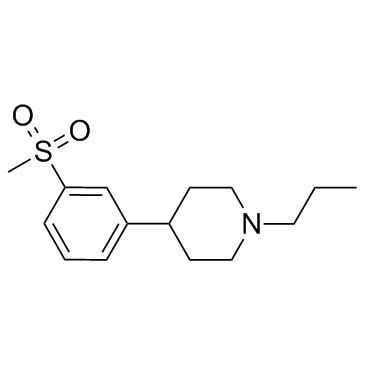Pridopidine (ACR16) |
| Catalog No.GC30854 |
Pridopidine (ACR16), a dopamine (DA) stabilizer, acts as a low affinity dopamine D2 receptor (D2R) antagonist.
Products are for research use only. Not for human use. We do not sell to patients.

Cas No.: 346688-38-8
Sample solution is provided at 25 µL, 10mM.
Pridopidine, a dopamine (DA) stabilizer, acts as a low affinity dopamine D2 receptor (D2R) antagonist. Pridopidine exerts high affinity towards sigma 1 receptor (S1R) with Ki between 70 and 80 nM, which is ~100× higher than its affinity toward D2R.
Pridopidine, a dopamine (DA) stabilizer, Pridopidine may be a neuromodulatory agent with neuroprotective properties in Huntington disease (HD). To clarify the neuroprotective efficacy of Pridopidine and to explore the potential underling molecular mechanism, the ability of Pridopidine is evaluated to protect cells from apoptosis and to eventually activate pro-survival targets. Administration of Pridopidine (150 μM), the most effective dose, significantly reduces apoptosis in immortalized striatal knock-in cells expressing endogenous levels of mutant Htt (STHdh111/111) and markedly enhances phosphorylation state of prosurvival kinase ERK[2].
Pridopidine is known to act as a low affinity D2R antagonist. Pridopidine's activity may be attributed to binding the sigma 1 receptor (S1R), an endoplasmic reticulum (ER). To strengthen the hypothesis that the BDNF pathway is upregulated due to activation of the S1R, SD rats are treated with lower doses of Pridopidine (range 0.3-60 mg/kg), and analysed the expression of seven selected genes in the BDNF pathway by qPCR. Pridopidine doses of 3 and 15 mg/kg in rats occupy 57±2% and 85±2% of S1R, respectively, and both do not show occupancy of the D2R, as determined by in vivo PET imaging. The significant occupancy proportion of the D2R (44-66%) is observed only at a dose of 60 mg/kg. This PET study supports the conclusion that the upregulation of genes in rats treated with 15 mg/kg Pridopidine are a result of specific activation of the S1R. At 30 mg/kg, partial/low occupancy of the D2R is at levels of 22-33% (assuming linearity), and S1R is saturated. Indeed, qPCR analysis reveals that the upregulation of EGR1 (already up at 3 mg/kg), EGR2, HOMER1A, KLF5, and ARC expression are upregulated at the low 15 mg/kg dose and expression of CDNK1A and CEBPB are significantly upregulated from a low dose of 30 mg/kg (CEBPB is significantly increased at 3 mg/kg but not at 15 mg/kg)[1]. To further confirm the beneficial effect of Pridopidine on HD motor phenotype and to elucidate whether Pridopidine may act also as neuroprotective agent, preclinical studies in R6/2 mice have been undertaken. Daily administration of Pridopidine at a dose of 5 mg/kg, the most effective dose with no adverse effects, starting at the pre-symptomatic stage at 5 weeks for 6 weeks, significantly preserves motor function and prevents the progressive and dramatic motor worsening commonly observed in R6/2 mice. The beneficial effects of Pridopidine are maintained for about 4 weeks, after which mice show a slight worsening in performing both the horizontal ladder task and the open field. In addition, according to a Kaplan-Meier survival curve analysis, Pridopidine efficiently extends lifespan in the same mice[2].
[1]. Geva M, et al. Pridopidine activates neuroprotective pathways impaired in Huntington Disease. Hum Mol Genet. 2016 Sep 15;25(18):3975-3987. [2]. Squitieri F, et al. Pridopidine, a dopamine stabilizer, improves motor performance and shows neuroprotective effects in Huntington disease R6/2 mouse J Cell Mol Med. 2015 Nov;19(11):2540-8. model.
Average Rating: 5 (Based on Reviews and 14 reference(s) in Google Scholar.)
GLPBIO products are for RESEARCH USE ONLY. Please make sure your review or question is research based.
Required fields are marked with *




















